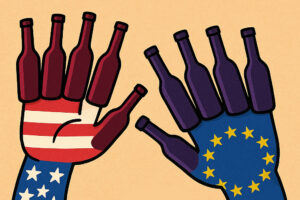The United States is by far the top destination for Italian wine exports, which, in the first 8 months of 2021, have already amply surpassed the billion euro (1.16 billion euros) mark in shipments, up on both 2020 (+22.7%) and 2019 (+19.4%). An enormous turnover, essentially linked to red wines, white wines and sparkling wines, mostly Prosecco, while rosé wines have so far accounted for just €35 million, or 13.63% of total imports of rosé wines, with France accounting for 72%, with sales in 2019 even exceeding €290 million. The market, however, as reported in the analysis “The rosé market in the United States” signed by Enolytics for Ita - Italian Trade Agency is much larger, and 83% is in the hands of the wines of American producers, with France accounting for only 11% in value. This is why it is so important to analyze a trend that represents the biggest innovation in the US market in recent years, together with Prosecco.
This is a trend that is anything but exhausted and in continuous evolution, which Italy must learn to understand in order to make its way in the glittering world of pink wines which, as the research tells us, experienced its “turning point” in 2007, when the consumption of rosé wines exploded, suddenly becoming glamorous, especially among the Millennials, protagonists at the poolside in an unmistakably “Provence-style” declination, at least in the shades. Since then, growth has been unstoppable: +1433% of volumes sold between 2010 and 2020, and 118% between 2015 and 2020, when still wine as a whole recorded a measly +1.5%.
And things are destined to go well in the future too, with Iwsr forecasting +70% between 2020 and 2024. In short, rosé wines are in full expansion mode, with a lot of potential to offer, especially if we look at alternative formats (such as cans) and the younger generations. In addition, rosés are finding a respectable place on the shelves of wine shops and on the wine lists of restaurants, and they respond perfectly to the demands of a market that is increasingly asking for wines with lower alcohol content.
Looking further into the future, the country of origin will be less important for the most important brands, as climate change has a negative impact on production and availability, while color is much more relevant in the eyes of the average consumer. Another trend to focus on is the opportunities offered by rosé sparkling wines, as demonstrated by the success of the pink version of Prosecco. Then, as already mentioned, there are the alternative formats, with rosé wines in cans growing by 2% in 2020, compared to a drop of 3% for bottles, but also the areas still to be explored in countries such as Florida and Georgia, where summer lasts practically all year round.
So the future for rosé wines is all “rosy”? Not really, because some obstacles do exist. First and foremost, the excess of supply that consumers are faced with, with a consolidation of the big brands, especially in the entry level, while there will still be room to grow in the $20 per bottle category. The historical moment is also not the best, as the collapse in consumption in 2020 has led to an erosion of prices for the 2018 and 2019 vintages, with the 2020s delaying their arrival on the market. The unfavorable exchange rate between the dollar and the euro is not helping the market either, nor are tariffs on imports - from France, Germany and Spain - which together with the pandemic have led to a collapse in US imports in 2020 of 4.5 million cases (equivalent to 54 million bottles).
Returning to the general situation, rosé wines are worth 7.1% of the US wine market in value terms and 9.3% in volume terms. Pink wines are the cheapest on the market: a case costs an average of $72.72, compared to $105.46 for red wines and $87.47 for white wines. We are talking about 6 dollars per bottle on the shelf, a price that cannot interest Italian producers, and in fact the market for rosé wines under 10 dollars is 85% in the hands of US producers, a share that drops to 60% in the 10-20 dollar range, with France rising to 30% and Italy to 5%. Similarly, above $20, 87% of the market is in the hands of French wines, mainly from Provence, 10% for Americans and 2% for Italians. And it is here, in the $20+ category, that Italy can and must aim, demonstrating that it has what it takes to erode France’s market share.
Finally, to be successful, you have to know the consumer. One of the great fortunes of the rosé is that it is a decidedly “gender-neutral” wine, witness to a light and carefree way of drinking wine, always open to innovation. Rosé wines, in the common imagination, are simple wines, about which one does not need to know much to feel comfortable drinking them, they are not considered a threat (as happens with other wines), and then “rosé” is easy to pronounce, and the wines are not tied to a specific variety, an aspect that goes against the approach to wine-making in Italy, where native varieties and territoriality have an enormous value and specific weight. Moreover, rosés today correspond to a very precise ideal: they are salmon pink, like those produced in Provence, beautiful to photograph and share on social networks, the undisputed reign of the youngest, with hashtags such as #roseallday, #hamptonwater or #rosealldamnday raging on Instagram.
The average rosé consumer is ultimately a woman, aged between 30 and 40, from the middle class. According to data analyzed by Enolytics, in fact, there is a 13% higher than average chance that a woman will buy a rosé wine online, a chance that is 15% lower than average among men. On a generational level, Millennials are 25% more likely than average to buy rosé, and 14% more likely than average among Gen X, while the chances are 14% lower than average among Boomers and Gen Z, and even 44% lower than average among the Silent Gen. Finally, belonging to a particular social class represents a negligible variance, although members of the middle class are 2% more likely than average to choose a rosé wine.
Copyright © 2000/2025
Contatti: info@winenews.it
Seguici anche su Twitter: @WineNewsIt
Seguici anche su Facebook: @winenewsit
Questo articolo è tratto dall'archivio di WineNews - Tutti i diritti riservati - Copyright © 2000/2025








































































































































































































